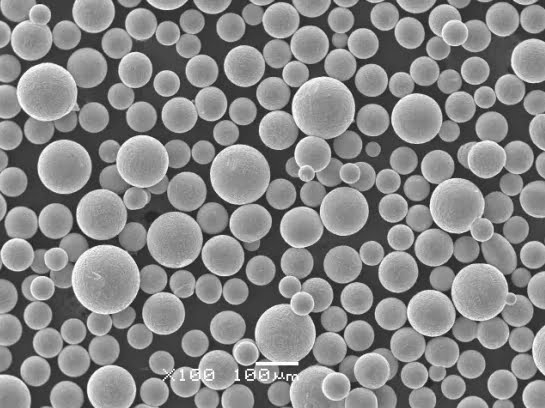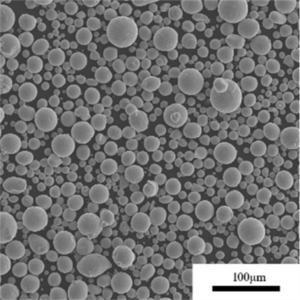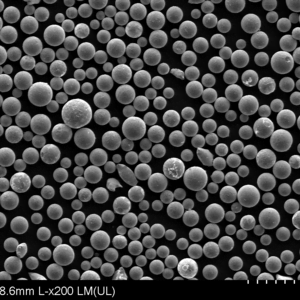AerMet100 Stainless Steel Powder
AerMet100 stainless steel powder is an advanced high strength and corrosion resistant alloy powder designed for additive manufacturing applications. With its unique composition and properties, AerMet100 enables production of high performance parts using 3D printing processes like laser powder bed fusion and binder jetting.
This article provides a comprehensive overview of AerMet100 stainless steel powder covering its composition, properties, applications, specifications, pricing, handling, inspection methods and other technical details.
Low MOQ
Provide low minimum order quantity to meet different needs.
OEM & ODM
Provide customized products and design services to meet unique customer needs.
Adequate Stock
Ensure fast order processing and provide reliable and efficient service.
Customer Satisfaction
Provide high quality products with customer satisfaction at the core.
share this product
Table of Contents
AerMet100 stainless steel powder is a high-performance alloy powder designed for additive manufacturing applications requiring high strength and fatigue resistance. Some key features of this material include:
- High strength and hardness – AerMet100 has excellent strength with tensile strength over 200 ksi and hardness ranging from 30-36 HRC.
- Good ductility – Despite the high strength, AerMet100 still retains decent ductility and impact resistance. Elongation values are over 10%.
- Excellent fatigue resistance – The fatigue limit of AerMet100 is very high at around 50% of tensile strength. This allows durable components exposed to cyclic stresses.
- Resistance to creep – AerMet100 resists deformation under load at high temperatures up to 700°C making it suitable for elevated temperature service.
- Corrosion resistance – The stainless steel composition provides corrosion and oxidation resistance for use in harsh environments.
- Weldability – The low carbon content allows for good weldability using standard fusion welding methods.
- Cost-effectiveness – AerMet100 is more affordable than other exotic alloys with similar properties.
This exceptional balance of properties makes AerMet100 suitable for demanding applications in aerospace, oil & gas, automotive, and industrial sectors. Parts made from AerMet100 powder demonstrate high strength-to-weight ratio, durability, and reliability under operating loads.
AerMet100 Stainless Steel Powder Composition
AerMet100 has a martensitic stainless steel composition with additions of cobalt, nickel, and molybdenum for strength and hardness. The nominal composition is given below:
| Element | Weight % |
|---|---|
| Iron (Fe) | Balance |
| Chromium (Cr) | 15.0 – 17.0 |
| Nickel (Ni) | 7.0 – 10.0 |
| Cobalt (Co) | 8.0 – 10.0 |
| Molybdenum (Mo) | 4.0 – 5.0 |
| Manganese (Mn) | < 1.0 |
| Silicon (Si) | < 1.0 |
| Carbon (C) | < 0.03 |
The key alloying elements and their effects are:
- Chromium – Provides corrosion and oxidation resistance
- Nickel – Increases toughness and ductility
- Cobalt – Solid solution strengthener, increases strength
- Molybdenum – Solid solution strengthener, increases strength and creep resistance
- Manganese & Silicon – Deoxidizers to improve powder manufacturability
- Carbon – Kept low for better weldability
The combination of these elements gives AerMet100 stainless steel its unique set of properties.
AerMet100 Stainless Steel Powder Properties
AerMet100 exhibits the following physical and mechanical properties in as-built AM and heat treated conditions:
| Property | As-Built | Heat Treated |
|---|---|---|
| Density | 7.9 g/cc | 7.9 g/cc |
| Porosity | < 1% | < 1% |
| Surface Roughness (Ra) | 15-25 μm | 15-25 μm |
| Hardness | 30-35 HRC | 34-38 HRC |
| Tensile Strength | 170-190 ksi | 190-220 ksi |
| Yield Strength (0.2% Offset) | 160-180 ksi | 180-210 ksi |
| Elongation | 8-13% | 10-15% |
| Reduction of Area | 15-25% | 15-25% |
| Modulus of Elasticity | 27-30 Msi | 29-32 Msi |
| CTE (70-400°C) | 11-12 μm/m°C | 11-12 μm/m°C |
| Conductivity | 25-30% IACS | 25-30% IACS |
The properties make AerMet100 suitable for high-strength structural components, aerospace fasteners, downhole tools, valves and pumps, and other critical parts where fatigue resistance is paramount.
AerMet100 Stainless Steel Powder Applications
The unique properties of AerMet100 make it an excellent choice for the following applications:
Aerospace
- Structural brackets, braces, fuselage components
- Landing gear parts, wing components, empennage
- Engine mounts, exhaust components
- Turbine blades, impellers, compressor parts
- High-strength fasteners, bolts, nuts, rivets
Oil & Gas
- Downhole drill tools and components
- Wellhead parts, valves, pumps
- Pressure vessels, pipe fittings
- Subsea/offshore structural parts
Automotive
- Power generation components
- Drive systems parts like gears, shafts
- Structural braces, chassis components
- High-performance racing components
Industrial
- Robotics parts subject to wear and impact
- Dies, molds, tooling
- Fluid handling parts like valves and pumps
- Other high-cycle loaded components
The excellent fatigue strength of AerMet100 makes it an ideal replacement for components traditionally made from titanium or nickel alloys. The high hardness provides good wear resistance as well.
AerMet100 Stainless Steel Powder Specifications
AerMet100 powder products meet the following specifications:
| Specification | Grade/Alloy |
|---|---|
| AMS 7245 | AerMet100 |
| ASTM F3056 | AlloySpec 23A |
| DIN 17224 | X3NiCoMoAl 15-7-3 |
Typical size distributions for AM processing are:
| Particle Size | Distribution |
|---|---|
| 15-53 μm | 98% |
| <106 μm | 99% |
Chemical composition must conform to the permissible ranges for elements like Cr, Ni, Co, Mo, C, etc. as outlined in AMS 7245 specification for AerMet100 alloy.
Mechanical properties should meet or exceed the minimum values for hardness, tensile strength, yield strength, elongation, and reduction of area stated in AMS 7245.
Non-destructive testing like dye penetrant or magnetic particle inspection should show no critical flaws or defects. Powder should have good flowability and exhibit no clumping.
AerMet100 Stainless Steel Powder Suppliers and Pricing
AerMet100 powder is available from the following major suppliers:
| Supplier | Product Designation | Price Range per kg |
|---|---|---|
| Carpenter Additive | CarTech AerMet100 | $85-110 |
| Höganäs | Digital Metal DM100 | $90-120 |
| Praxair | TRU100 | $80-100 |
| Sandvik Osprey | Osprey Met 100 | $75-95 |
Prices vary based on order volume, lot size, regional distributor, and other discounts. Smaller research quantities may cost more than bulk production volumes.
Storage and Handling
To maintain quality of AerMet100 powder for AM use, the following storage and handling guidelines apply:
- Store sealed containers in a cool, dry place away from moisture and sources of contamination
- Avoid exposing powder to high humidity (>60% RH) for prolonged time
- Allow powder to equilibrate to room temperature prior to unsealing container to prevent condensation
- Pour and transfer powder in inert environments with low oxygen content if possible
- Use powder handling equipment and accessories made from compatible materials to prevent contamination
- Limit reuse of powder to 2-3 cycles maximum to prevent degradation of properties
- Conduct testing of used powder to ensure it still meets all specifications for reuse
Proper storage and careful handling is key to preventing powder oxidation, contamination, or changes in flowability.
Safety Information
- Wear PPE when handling powder – gloves, respirator mask, goggles
- Avoid skin contact to prevent possible allergic reactions
- Prevent inhalation of fine powders over long periods
- Ensure adequate ventilation and dust collection when processing
- Use non-sparking tools to dispense and handle powder
- Inert gas blanketing is recommended for powder handling
- Follow all applicable safety data sheet (SDS) guidelines
- Dispose according to local regulations and ensure containment
AerMet100 alloy powders are generally not hazardous materials but following basic safety practices during storage, handling, and processing is advised.
Inspection and Testing
To ensure AerMet100 powder meets specifications, the following inspection and testing procedures can be used:
| Test Method | Property Validated |
|---|---|
| Visual inspection | Powder flowability, contamination |
| Scanning electron microscopy | Particle size distribution and morphology |
| Energy dispersive X-ray spectroscopy | Alloy chemistry, contamination |
| X-ray diffraction | Phases present, contamination |
| Hall flowmeter | Powder flow rate |
| Apparent density | Powder packing density |
| Tap density test | Powder flowability |
| Sieve analysis | Particle size distribution per ASTM B214 |
| Chemical analysis | Composition per AMS 7245, oxides |
| Density measurement | Powder density vs AMS 7245 |
Mechanical testing of printed specimens per AMS 7245 validates final part properties meet requirements. Testing methods include hardness, tensile, charpy impact, high cycle fatigue, low cycle fatigue, creep rupture, fracture toughness, corrosion, etc.
AerMet100 Stainless Steel Powder Comparison to Similar Materials
AerMet100 compares to other high-strength martensitic stainless steels as follows:
| Alloy | Strength | Ductility | Weldability | Cost |
|---|---|---|---|---|
| AerMet100 | Very high | Moderate | Fair | Moderate |
| 17-4PH | High | Low | Poor | Low |
| Custom 465 | Very high | Low | Poor | High |
| 316L | Moderate | High | Excellent | Low |
| Inconel 718 | High | High | Moderate | Very high |
Advantages of AerMet100:
- Higher strength than 17-4PH and 316L
- Better ductility than Custom 465 for higher impact resistance
- More weldable than precipitation hardening alloys
- Lower cost than Inconel 718
Limitations of AerMet100:
- Lower ductility/fracture toughness than austenitic 316L
- Inferior weldability compared to 316L
- Higher cost than 17-4PH or 316L
- Lower strength than Custom 465 in peak aged condition
Overall, AerMet100 provides an optimal combination of strength, ductility, weldability, and cost for high-performance parts made by AM processes.
FAQ
Q: What are the key benefits of AerMet100 alloy?
A: The main benefits of AerMet100 are its high strength and hardness coupled with good ductility, excellent fatigue resistance, creep resistance, corrosion resistance, and moderate cost. This makes it well suited for critical AM applications.
Q: What heat treatment is used for AerMet100?
A: A typical heat treatment is 1-2 hours solutionizing at 1040-1080°C followed by air or furnace cooling to room temperature, then age hardening at 480°C for 4 hours to achieve optimal strength and hardness.
Q: What welding methods can be used to join AerMet100 parts?
A: Fusion welding methods like GTAW, GMAW, and PAW are recommended for AerMet100 to avoid cracking and minimize distortion. Low heat input and peening of welds is also suggested. Brazing can also produce good joints.
Q: How does AerMet100 compare to maraging steels for AM?
A: AerMet100 has higher ductility but slightly lower strength than maraging steels like 18Ni300 or 18Ni350. Maraging steels have poor weldability. AerMet100 is a good lower-cost alternative to maraging.
Q: Can AerMet100 be machined after AM processing?
A: Yes, AerMet100 can be machined after AM but care must be taken to account for work hardening effects. Low cutting forces, carbide tooling, and adequate coolant is recommended. Annealing may be required after extensive machining.
Q: What particle size range of AerMet100 powder is optimal for AM?
A: The recommended particle size range for AM is 15-45 μm. Finer powders improve resolution but can negatively impact flowability. Coarser powders above 53 μm can cause print defects. The typical sweet spot is 25-35 μm.
Get Latest Price
About Met3DP
Product Category
HOT SALE
CONTACT US
Any questions? Send us message now! We’ll serve your request with a whole team after receiving your message.

Metal Powders for 3D Printing and Additive Manufacturing
COMPANY
PRODUCT
cONTACT INFO
- Qingdao City, Shandong, China
- [email protected]
- [email protected]
- +86 19116340731













